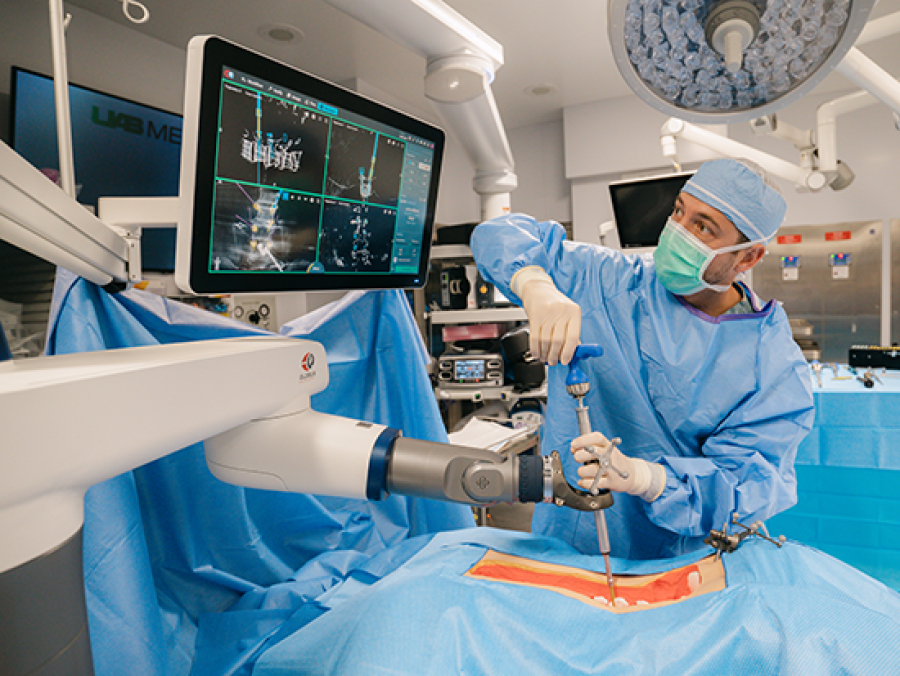
Robotics and Minimally Invasive Spine Surgery
Minimally Invasive Spine Surgery (MIS) has become a cornerstone of modern spinal care, offering patients smaller incisions, less blood loss and faster recovery, compared with traditional open techniques. While effective, MIS procedures present unique challenges, due to limited visibility and narrow surgical corridors. Robotics is increasingly bridging this gap. Dr. Larry Davidson, a leader in minimally invasive spinal surgery, has highlighted how robotic systems make MIS safer and more efficient, allowing surgeons to achieve precise outcomes, without the drawbacks once associated with small-incision surgery.
The combination of robotics and MIS represents one of the most important shifts in spine surgery. By pairing digital planning, intraoperative navigation and robotic stability, surgeons can place hardware accurately, preserve tissue and reduce operative time. For patients, this means the benefits of MIS are delivered more consistently, with fewer risks and stronger long-term results.
The Promise of MIS
MIS was developed to reduce the trauma associated with open surgery. Instead of long incisions and wide muscle dissection, MIS uses tubular retractors, endoscopes and specialized instruments to access the spine through small openings. The benefits include reduced pain, shorter hospital stays and faster returns to activity.
Despite these advantages, MIS has limitations. Narrow working spaces reduce visualization, and hardware placement is more technically demanding. These challenges can increase operational time and, in some cases, compromise accuracy. Robotics overcomes these challenges by guiding instruments with millimeter-level precision, allowing the advantages of minimally invasive surgery to be achieved safely.
How Robotics Enhances MIS
Robotic systems combine preoperative imaging with intraoperative navigation, enabling surgeons to plan screw trajectories, implant sizes and spinal alignment, before surgery starts. During the procedure, the robot guides instruments along these planned paths, maintaining accuracy, even with the limited visibility of minimally invasive surgery. This approach reduces dependence on fluoroscopy, lowering radiation exposure for patients and surgical teams, while also minimizing variability, to make MIS procedures as safe and effective as traditional open surgery.
Precision in Small Spaces
One of the greatest challenges in MIS is achieving accuracy in small spaces. Traditional methods depend heavily on surgeon experience and tactile feedback, which can be limited through narrow corridors. Robotic arms provide stability and guidance, holding instruments steady as surgeons work through small incisions.
This precision is especially valuable in pedicle screw placement, where even a few millimeters can determine success or failure. Robotics helps secure screws accurately, avoiding bone breaches or injury to nearby nerves. It turns minimally invasive surgery from a technically challenging approach, into a predictable, reproducible procedure, that more surgeons can safely perform.
Robotics in Fracture Care
Spinal fractures often require stabilization in anatomies distorted by trauma. MIS alone can be difficult in these cases due to altered landmarks. Robotics provides the guidance needed to place screws and rods accurately, through minimally invasive approaches, preserving muscle, while restoring stability. By combining MIS and robotics, surgeons can offer fracture patients the benefits of smaller incisions, without compromising precision. It reduces recovery times, while maintaining strong long-term outcomes.
Dr. Larry Davidson remarks, “Combining advanced robotic tools with surgical expertise elevates patient care, by making procedures safer and recovery more manageable.” This perspective underscores how robotics transforms minimally invasive spine surgery from a technically demanding approach, into a consistently reliable option, aligning precision with patient-centered outcomes.
Robotics in Deformity Surgery
Deformity corrections traditionally required large incisions and significant tissue disruption. Robotics is changing that by enabling surgeons to place hardware precisely, through smaller openings. Long constructs can now be placed minimally invasively, reducing blood loss and recovery times for complex cases. Robotics allows MIS to be applied to more patients, including those with challenging deformities. By improving accuracy, robotics expands the scope of what minimally invasive techniques can achieve.
Athletes and MIS with Robotics
Athletes benefit greatly from MIS because of its faster recovery times. Robotics enhances this benefit by making sure that hardware placement supports both healing and performance. For athletes seeking to return to competition quickly, robotic-assisted MIS provides a balance between precision and reduced surgical trauma. By lowering complication risks and strengthening outcomes, robotics protects athletic careers, while reducing downtime. Rehabilitation programs can begin sooner, with confidence that repairs are stable and accurate.
Training the Next Generation
As robotics becomes central to MIS, surgical education is adapting. Residents and fellows are now trained to combine MIS techniques with robotic systems, practicing in simulation labs, before entering the operating room. Mentorship remains essential. Robotics supports that accuracy, judgment and patient communication remain critical. Training emphasizes that technology enhances, but never replaces, the surgeon’s role in decision-making and care.
Advances on the Horizon
Future developments promise even greater synergy between robotics and MIS. Smaller, more portable robots will make the technology accessible to a wider range of hospitals. Integration with AI may allow real-time adjustments to screw placement based on intraoperative changes in anatomy. Improved haptic feedback could give surgeons a better sense of touch, while maintaining robotic guidance. These advances will make MIS even safer, faster and more reliable in the years ahead.
Patients as Partners
Patient education is an important part of robotic-assisted MIS. Understanding how technology improves safety and precision helps patients feel confident in their surgical plan. Informed patients are more engaged in their recovery, following rehabilitation protocols with greater trust in their care team. By framing robotics as a tool that supports, not replaces, surgeons, providers strengthen patient confidence and collaboration.
The combination of robotics and MIS represents one of the most promising trends in spine surgery. By improving safety, efficiency and outcomes, robotic-assisted MIS is expanding the possibilities for patients, once limited to open procedures. For patients, this future means less pain, shorter recoveries and stronger results. For surgeons, it represents a partnership between skill and technology, that raises the standard of care.
Robotics elevates minimally invasive spine surgery by adding precision, efficiency and consistency to procedures that were once limited by narrow corridors and reduced visibility. The outcome is safer, more effective care, with faster recovery times. This perspective highlights that robotics makes MIS not just feasible, but practical for a broader range of patients, offering a future where smaller incisions, guided by advanced technology, provide both safety and meaningful recovery.

